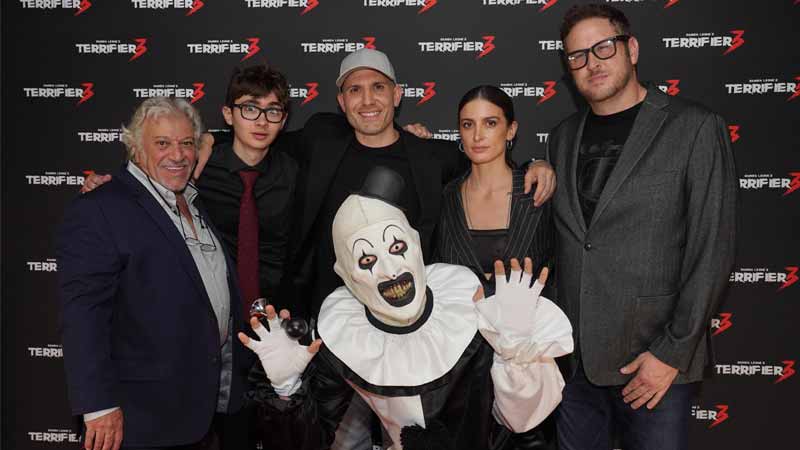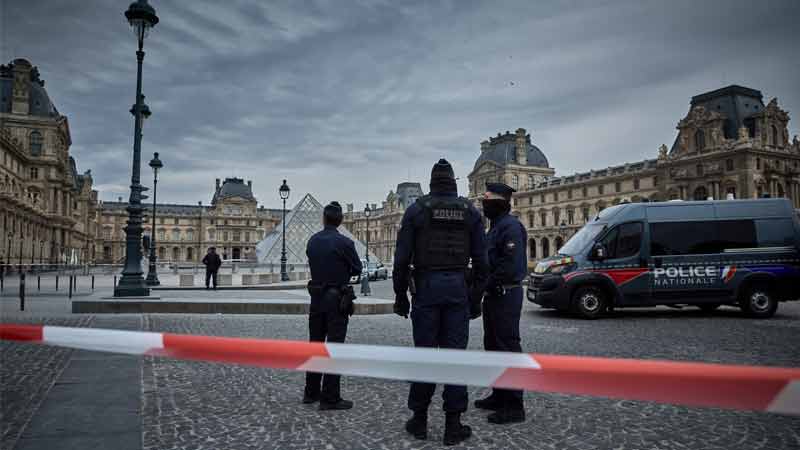 Image Credit: Jonathan Brady - PA Images / Contributor / Getty
Image Credit: Jonathan Brady - PA Images / Contributor / Getty It’s Halloween season, so it’s appropriate for Highly Respected to discuss SCARY movies. This week’s IQ Supplement will discuss the horror classics of the 1970s and how they made the genre what it is today. Today’s column will discuss some of the most important horror films of the last decade.
The Witch, the Terrifier film series, and the Suspiria remake present different elements of modern horror. Robert Eggers’ witchy film exemplifies the A24 trend of moody arthouse productions that aim to transcend the genre’s schlocky stereotypes. Many of these films suck and are unbearably woke. The Suspiria remake epitomizes the terrible quality of arthouse horror. The Witch, however, is very good. In contrast to the feminist interpretations of the film, it’s a right-wing work. It represents a type of horror that there should be more of. Colonial America offers a rich palette for scary writers and directors to work from. It’s a shame more films haven’t been set in this period.
The Terrifier trilogy is the opposite of A24 fare. While the highbrow films don’t shy away from the gruesome, they look tame compared to the gorefests created by Damien Leone. In fact, Terrifier 2 makes The Texas Chain Saw Massacre seem more like Barney’s Great Adventure. They’re extremely visceral films that aim to disgust and shock. The sawed-off women, severed heads, and extreme mutilation aren’t meant to stimulate the intellect. It’s pure blood and guts. The Terrifier films, unlike A24 fare, fully embrace low-budget shock. It gives them a certain charm and is sometimes refreshing compared to the big budget mundanity of the Conjuring series and overly pretentious arthouse pictures. Yet, for all the qualities of the Terrifier series, they are sick films. I wouldn’t say we should censor them, but good taste would probably dictate that they weren’t made in the first place.
In the past, this would’ve been a universal opinion among right-wingers. Today, it’s bound to generate fury among the Online Right, as I learned last year when I merely called Terrifier 3 a “nihilistic gorefest.” (It is in fact a nihilistic gorefest.) Conservative defenders of the series insist it’s Christian. It’s an idiotic claim, as I’ll explain in the first part of this horror review.
Terrifier’s Alleged Morality
For those not familiar with the story of Terrifier, it’s simple. It centers on a deranged clown named Art who sadistically murders people. He eventually becomes possessed by a demon, making him a supernatural monster rather than a mere mortal. In the second film, Art meets his match in final girl Sienna Shaw, who becomes imbued with angelic powers to combat the demonic clown. It’s a slasher, so obviously Art finds a particularly gruesome way to return to the world for the subsequent film after being beheaded by the heroine in the second one.
The Sienna Shaw character is primarily why the Terrifier films are argued to be Christian. It’s not a take limited to the idiots in my mentions. There’s a couple of articles published at reputable outlets that make this claim. One of which is written by Cameron Frew for Dexerto. Frew claims that Terrifier 3 is “among the most theologically interesting films since [The Passion of the Christ], and the first movie in 20 years to convey the suffering of a saviour. Only their name isn’t Jesus; it’s Sienna.”
Frew goes into great detail about all the biblical and Christian imagery in Terrifier 2 and 3 in his review. Sienna is resurrected to defeat Art in the second film. Mary imagery is prevalent throughout the third film. Leone, the director, even seemed to endorse the theory it’s a Christian film in response to protests against his work. “The Bible is very violent,” he told the Los Angeles Times. “If you only saw the movie… you’d see some really pro-God stuff in this movie.”
It’s not an anti-Christian film, by any means. But alluding to the Bible’s violence to defend it is a bit much. Frew claims the films aren’t all about violence. That’s mistaken. People see the movies for the extreme violence and gore, not the religious imagery. The main message isn’t “Jesus saves,” it’s “look at Art carve up a teenager in front of her mother.” It’s hard to claim a film that includes the brutal murders of children offers a spiritually-enriching message.
The film invites viewers to relish the pain and suffering of the characters in a way that’s perverse. Slashers in the past were heavily policed by the MPAA to not show the twitching and suffering of the dead. Jason Voorhees and Michael Myers dispatched their victims quickly. Art the Clown, in contrast, makes sure his victims experience maximum suffering. Viewers are forced to watch as the victims writhe and scream in agony as the clown makes their final moments on earth a living hell. This is the draw of the movie. It doesn’t seem very Christian to invite viewers to revel in the suffering of hapless victims.
There have been horror films that could be called Christian. The Exorcist is practically Catholic propaganda. You do not laugh with or sympathize with Pazuzu. You do laugh with Art, and you’re even at times invited to root for him. The Exorcist is completely black-and-white. God is real and good. The devil is evil and runs amok. Only true faith and the Church can counter this infernal menace. In spite of the grotesqueries of The Exorcist (which look tame today), it still offers a strong Christian message. The possessed girl throwing up on the priest isn’t the sole draw of the film.
But even the Church was uncomfortable with the film, believing it was too gruesome and too inclined to lead viewers to the occult. One would love to hear what the bishops think of Terrifier 3!
No matter how many biblical allusions are thrown in, the viewing experience of the Terrifier series isn’t changed. As someone who devoured films like Cannibal Holocaust as a teen and generally despises censorship, Terrifier violates good taste and standards. If people like it for what it is, that’s fine. But it’s moronic to try to argue it’s a Christian film. I wouldn’t say I hate them, nor would I say they’re bad. They certainly have their merits. I particularly like the films’ synthwave soundtracks. But there’s something repulsive about them that can’t be covered up by a few crucifixes and pictures of the Virgin Mary.
But, like a car crash, I can’t look away. I probably will see Terrifier 4 when it comes out.
The Witch And The Need For Order
There’s a much better argument for The Witch to be a right-wing film than there is for Terrifier 3 to be a Christian work. The Witch contains its fair share of blood and disturbing imagery. But the draw of the film is not to watch victims get hacked to death in excruciating fashion. Its primary purpose is to convey the terror of living on the New England frontier. The film centers on a Puritan family that happily accepts banishment from their community over theological differences. William, the patriarch, accuses his fellow Puritans of failing to fully live out the word of God and defies their authority. He takes his family out into the wilderness to create his own version of the Kingdom of God.
It doesn’t go well. William proves to be an inept patriarch as his whole family revolts against his authority and goes mad.
It’s a film that’s been widely interpreted as feminist for how the patriarchy allegedly oppresses Thomasin, the family’s eldest child (played by Anya Taylor-Joy). It’s what made it earn plaudits in the media in the woke 2010s. It was released at a time when films, especially horror films, wanted to seem progressive–and critics were happy to interpret them that way. The silly Satanic Temple, a group of reddit atheists who don’t actually worship the devil, praised the film as “a story of female rebellion and accepting outsider status.”
The film does depict those things, but they’re cast as bad. It depicts the destructiveness of rebellion against established order. The outsiders are not the good guys. The witches in the film literally eat children and bathe in their blood. Their hideousness illustrates their wickedness. The family themselves are outsiders, and the horror that strikes them is caused by rebellion against their own people. They’re left on their own to be preyed upon by the witches’ coven.
The father’s revolt against order sets a terrible example for his kids. All of the misfortune follows from this. The family’s eldest son becomes bewitched and loses the family’s horse, gun, and dog after disobeying the father’s orders not to go in the woods. The family’s young twins defy authority at all possible moments and eventually make a pact with the devil. This obviously brings further suffering on the family. Thomasin tries her best to follow the family’s rules, but supernatural intervention gets in the way. Her joining the coven is less of an act of radical liberation and more of a desperate act of survival. She has no one left and she can’t return to the Puritan community due to the taint of witchcraft. The devil forces her to join, and liberation requires her to commit evil deeds.
The message of the film is not “patriarchy is bad.” It depicts the perils of rebellion and the need for proper order. If William hadn’t been a sperg and felt he knew better than his community’s elders, he wouldn’t have doomed his family. Civilization, not wild nature, is the force for good. It’s not the Puritans who are eating children. Making yourself an outsider leaves you vulnerable to the forces of chaos. You can go your own way, but there’s a heavy price to pay.
The Suspiria Remake May Be My Most Hated Film
It’s a pity that most highbrow horror don’t reach the quality of The Witch and are instead complete tripe like the 2018 Suspiria remake. After watching the lengthy, feminist snoozefest, you gain a new appreciation for Terrifier 2. You wish Art had shown up to brutally murder every single character in the film. One would not feel guilty at all about seeing the demonic clown slice and dice the pompous witches of Suspiria with reckless glee.
I deeply loathed this movie. It’s really not a horror movie. It’s a standard, extremely pretentious European arthouse film about a ballet school, complete with a hamfisted message about German national guilt and the patriarchy. There’s greater focus in the film on the characters drinking mineral water than any kind of scare. The soundtrack, composed by Radiohead’s Thom Yorke, sucks and is completely out-of-sync with a horror film. A few lame horror scenes are thrown in. One doesn’t even think the bad guys (or rather gals) are that bad. You’re invited to side with them and admire their quirky lifestyle. They love drinking fine wine, laughing with the girls, and standing up to fascism. What’s not to like about them, besides that they sometimes kill girls who try to leave the ballet school?
The main character of the film turns out to be the master witch who deploys the black arts and demons to… stand up for women and Holocaust survivors.
One of the final scenes features the main character (played by Dakota Johnson) visiting an elderly Holocaust survivor who’s been investigating the witch coven. The protagonist is a demonic witch capable of mass murder. But she’s good because she opposes Nazis, as made clear in this scene where the heroine tells what happened to the geriatric’s lost wife during World War II. The real evil is what Germans did in the past, not the black arts conjured up by this badass.
This makes it different from The Witch. In that film, the witches are clearly bad and the social order is good. That’s reversed here. The witches are good (or at least half of them are) and the social order is bad. The real villains aren’t the witches, but German men and the protagonist’s bigoted Mennonite family, which for some reason didn’t want her learning about Germany and cruelly punished her for childhood offenses. The message: witchcraft allows women to strike back against Christianity, fascism, and the patriarchy. We just need to make sure it’s the real Mother of Sighs leading the coven, not the pretender Helena Markos.
I could go on forever about how every scene sucks. But I will just note that literally nothing happens for the first 35 minutes. We are then treated to a goofy scene of a hexed dancer breaking her body under the control of unseen forces. We’re then back to more pretentious scenes of the characters discussing the Red Army Faction (a plotline never really explained) and making very serious faces. Tilda Swinton for some reason plays three different characters in the film, one of whom is the only male role that speaks at length. A woman playing an elderly man in costume further undermines this film’s lame terror and makes it idiotic.
The original Suspiria is one of the best horror movies all-time. In the original, the witches are bad, they’re not explained, there’s no political message, and it’s a rich aesthetic experience. It packs a punch and has a soul. Like all great horror, it relies on fear of the unknown to animate its terror. In the remake, the audience is explained everything and we don’t fear anything happening. We, in fact, want all these characters to die because they fucking suck. The original also has an incredible soundtrack scored by the prog rock band Goblin. The theme will stick in your head for days, unlike the uninspired, whiny tracks composed by Thom Yorke for the remake. The original’s director, Dario Argento, hated the remake, saying “it did not excite me, it betrayed the spirit of the original film: there is no fear, there is no music.” He was 100 percent correct.
Horror is a cool genre. Right-wingers shouldn’t dismiss it out of hand as inherently evil and should engage with it, especially as it becomes a bigger part of the film industry. Hopefully, we see more horror set in colonial America and fewer pretentious shit like the Suspiria remake.


